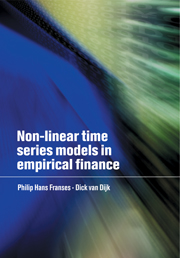3 - Regime-switching models for returns
Published online by Cambridge University Press: 14 May 2010
Summary
In this chapter we turn to one of the main subjects of this book, nonlinear models for returns. The problem one immediately faces when considering the use of nonlinear time series models is the vast, if not unlimited, number of possible models. Sometimes economic theory is helpful in choosing a particular model, but more often it is not. Nonlinearity in stock prices and exchange rates has often been detected by various statistical tests, (see Hinich and Patterson, 1985; Scheinkmann and LeBaron, 1989; Hsieh, 1989, 1991; Crato and de Lima, 1994; Brooks, 1996, among others). However, only few attempts have been made to subsequently model the nonlinearity explicitly. In this book we restrict ourselves to models that have a clear interpretation and are plausible from an economic perspective. For previous and more general surveys on nonlinear time series models, the interested reader is referred to Tong (1990) and Granger and Teräsvirta (1993).
A natural approach to modelling economic time series with nonlinear models seems to be to define different states of the world or regimes, and to allow for the possibility that the dynamic behaviour of economic variables depends on the regime that occurs at any given point in time (see Priestley, 1980, 1988). By ‘state-dependent dynamic behaviour’ of a time series it is meant that certain properties of the time series, such as its mean, variance and/or autocorrelation, are different in different regimes.
- Type
- Chapter
- Information
- Non-Linear Time Series Models in Empirical Finance , pp. 69 - 134Publisher: Cambridge University PressPrint publication year: 2000
- 1
- Cited by



